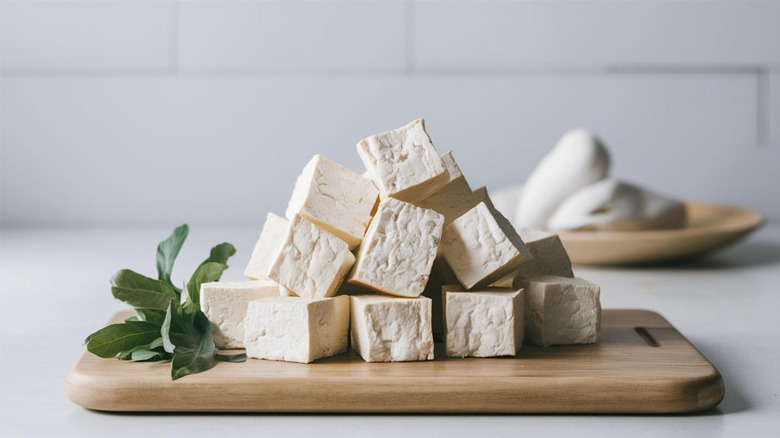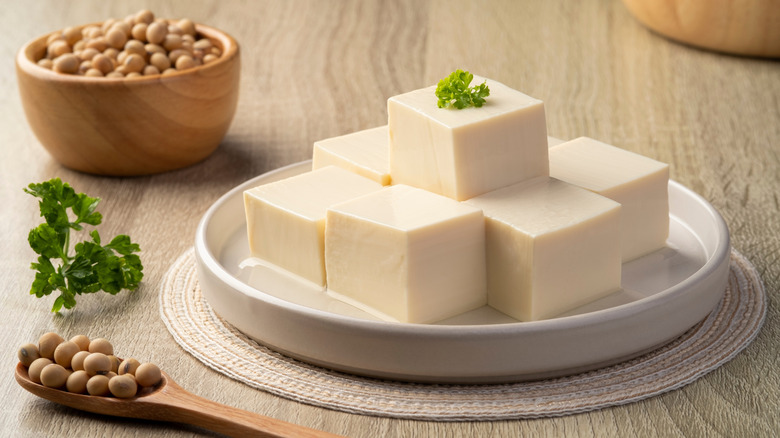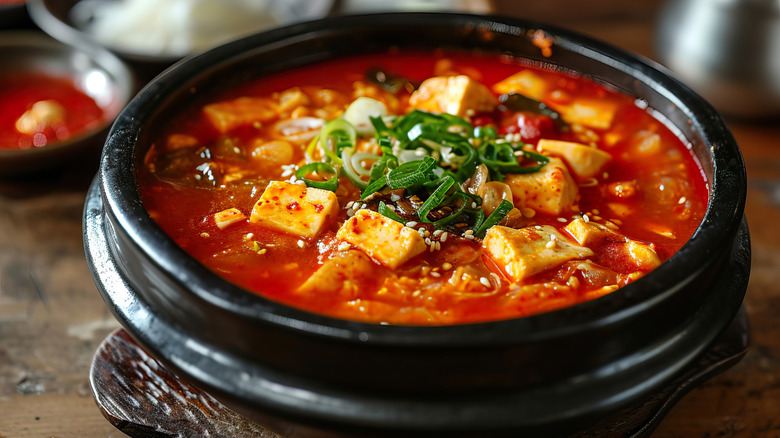How Is Silken Tofu Different From Regular Tofu?
With all the different types of tofu, understanding their differences and which kind to use in recipes can be confusing. The two main types include regular tofu, also known as bean curd, which has less water thanks to the whey being removed, and then there's silken tofu, which has a much silkier consistency thanks to the curds and whey being blended together. Tofu was invented in ancient China, thus the regular version is also known as Chinese-style tofu. Soft silken tofu was developed after regular tofu was introduced into Japan, so it's known as Japanese-style tofu.
Regular tofu comes packed in water, usually in square plastic tubs, which require refrigeration. You'll find it in the cold section of most supermarkets, often near the produce or natural foods. Silken tofu is usually sold in aseptic shelf-stable boxes which do not need to be chilled. You might find them either in the baking aisle, with dry goods like rice and pasta, in the Asian foods or international section, or sometimes near the cold tofu. If you have access to a Japanese tofu shop or Asian grocer, you can also sometimes get fresh tofu.
The differences also extend to how tofu is used. Due to its firm texture, regular tofu holds its shape when cooked. It works well when stir-frying, baking, frying, or grilling, and it's got a chewy, toothsome bite to it that makes for a perfect vegetarian meat stand-in. Silken tofu is more like pudding or custard and is great for making creamy non-dairy sauces, adding protein to smoothies, or creating custardy pie fillings.
Silken tofu is made from pure coagulated soy milk
Both kinds of tofu are made using the same ingredients, but how they are produced gives them their distinguishing characteristics. Both begin as mature white soybeans that get processed into boiled soy milk, to which a coagulant is then added. For regular tofu, the coagulated bean curd is separated from the plant milk's whey. The curds are then pressed to remove water ... the more water removed, the more rigid the tofu. This is how we get a range of densities, from soft, to medium, firm, and extra-firm. With very few ingredients, you can follow a step-by-step guide to making tofu at home for the freshest product possible.
To create silken tofu, the soy milk's curds are not separated from the whey, and the water is not removed. The coagulated milk is added right into its packaging in this form to set. While regular tofu does not have a lot of flavor on its own, silken tofu has not been through the same sort of filtration, so it retains more of a milky taste and fatty creaminess.
You can eat raw tofu right out of the package, and this is where the silken variety really shines, as its flavor is more prominent and the silky texture it's named for is most noticeable. Regular tofu, however, really benefits from having its water pressed out before cooking, which allows it to better soak up the flavors of marinades and spices. Freezing firm tofu also gives it an appetizing spongy texture, which is even further enhanced by freezing your tofu twice.
Recipes that feature silken tofu
Tofu is a staple in various Asian cuisines but is so versatile that it's used in many other types of cooking. Westerners may not be as familiar with silken as they are with regular tofu, which has become well-known for dishes like vegan tofu scramble, African tofu curries, and meat-free veggie burgers. Silken tofu is just as useful as a substitute, for example, you can use it to make mayo without eggs. It's also an excellent binder that can replace eggs in pancakes, waffles, and baked goods like brownies.
Silken tofu is a star in traditional Japanese recipes. It's served cold as hiyayakko, topped with things like soy sauce or ponzu, grated ginger, scallions, bonito flakes, and sesame seeds. Yudofu is similar but the tofu is first boiled in dashi broth before toppings are added. Agedashi is silken tofu dredged in potato starch that's gently deep-fried.
Chinese cooks use silken tofu in egg drop soup as a thickener — and in mapo tofu made with ground pork and Sichuan peppers. Soft tofu takes center stage in Korean hot pot jjigae stew and spicy soon (soondubu) soup, with tofu house restaurants that headline the ingredient having become as popular in places like Los Angeles' trendy Koreatown as they are in Seoul.



